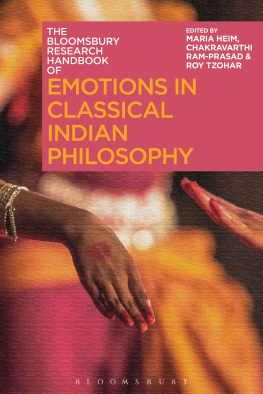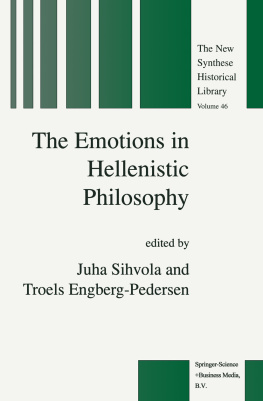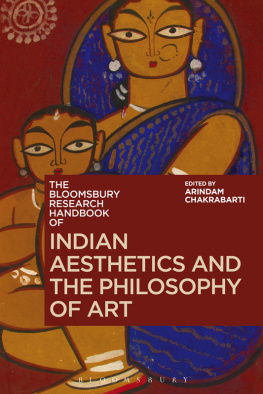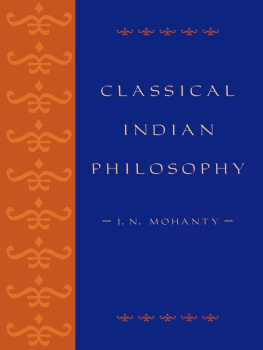Passions and Emotions in the Indian PhilosophicalReligious Traditions
RAFFAELE TORELLA
Anyone enquiring into the status of passions and emotions in traditional India is surprised to find that the subcontinent, so avid for analysis in every field of knowledge, has never produced any science similar to Western psychology. As a first response, what comes to mind is the gymnosophists answer to Socrates who was questioning him about mans nature: But how can we deal with the human before knowing about the divine? Too busy contemplating the fearful symmetries of the supernatural, were the Indians consequently not particularly interested in untangling the developments of human behaviour? The absence of psychology, as an independent discipline at least, appears all the more surprising if one considers that the Indians have never lacked a capacity either for introspection or for cataloguing. With the former, they have achieved results never surpassed in research on the two realities which, since they naturally coincide with the observersubject, lend themselves the more readily to eluding observation. I refer to breathing, the breath of life, literally dissected by yoga, and language, the subject of the most discerning analysis that humankind has ever devoted to this fundamental and pervasive reality. The Indians have never been in short supply with regard to their cataloguing ability and, on the contrary, have raised it to even maniacal levels, so that it is rampant in all scientific, aesthetic, philosophical, and religious literature, and is often one of the prime reasons for making its reading so arduous. The first great philosophical system to develop from Upaniadic and epic speculation was given the name Skhya, meaning (related to) enumeration, listing.
It is in fact in philosophical texts, starting precisely from those of the Skhya school, that we should look for a thesaurus of human passions and emotions, analysed and classified with obstinate accuracy and an absolutely neutral and scientific grasp, as in the classical texts of Vaieika, or else with a mixture of coldness and preoccupation, as often occurs in Buddhist and Jaina texts that describe them, keeping their gaze fixed on the meditating devotee who might be threatened by them. But the researcher into Indian passions and emotions will soon discover with equal surprise that he must delve into treatises on aesthetics and rhetoric perhaps even more than into philosophical and religious texts. Risking here, moreover, to lose both the reader and himself in labyrinthine systematics, in his investigation of the essence of poetry and the theatre, the Indian rhetorician must first tackle the basic human passions/emotions (bhva), which the poet or actor must portray so that the reader or spectator can savour their essence, finally liberated from the restrictions of the individual ego.
If, now satiated by descriptions albeit often of great precision the researcher of passions wishes to discover how they are assessed in the Indian world, things become even more complicated. Passions are differently assessed according to the subjects social position his belonging to one or another of the four basic stages of life (rama) and according to caste. While anger and disdain (manyu), as Minoru Hara (2001) has demonstrated in one of his seminal lexical analyses, are generally reprehensible in the man of the street, they are even obligatory for those belonging to the katriya class of sovereigns and warriors.
In examining the philosophicalreligious texts of Hinduism on such themes, we must first be aware that the greater part of them comes from the Brhmaical elite, which thus seeks to envelop the entire Indian reality in its coils. Our first impression after observing the central stream of Brhmaical thought is of a considerable integration mostly absent in the West of the individuals physical, psychicemotive and intellectual dimensions. A single nature runs through them uninterruptedly: it passes fluidly from one level to another, gradually including the animal and vegetal worlds. In the words of Louis Dumont:
Il ny a pas de coupure entre lhomme et la nature. La chose est sensible dans le vtement le corps senroule dans une pice dtoffe dans la simplicit de lavie matrielle et la forme des objets dusage courant. En musique, lheure de la journe prescrit le ton sentimental de la mlodie: impossible dtre nostalgique le matin et gai le soir.
There is no hiatus between man and nature. This is appreciable in clothing the body wraps itself in a piece of cloth or in the simplicity of material life and the form of objects we use every day. In music, the time of day prescribes the sentimental mode of the melody: impossible to be nostalgic in the morning and gay in the evening (1975: 30, in Bouiller and Tarabout 2002: 18).
Albeit deeply rooted in common opinion, such a view is, however, substantially a blunder: far from being absent, dualism is merely radicalised to the extreme. In Skhya, for example and Skhya with its cosmogenesis remains the model for much of the later Brhmaical speculation (cf. Torella 1999) an apparently unbridgeable abyss separates the world of nature (prakti), which comprises the body, senses, passions, and mental functions that form an integrated whole, from the world of the spirit, which alone is responsible for striking the spark of consciousness, without which the continual gross activity of the sensorial faculties, of the inner sense, of the I-notion, and the intellect could never finally shine as knowledge. An integrated monism of body, senses, emotions, and intellectual faculties consequently exists, but leaves out that very principle that alone can give meaning to the whole. The goal is not the final achievement of greater unity, but the recognition of an irremediable otherness, having reached which, the psychebodynature complex progressively withdraws from the scene, like a dancer, recounts a famous stanza of the Skhyakrik (59), having presented her performance to her audience, leaving the spirit to shine in undisturbed solitude. The material, emotional and psychic universe thus comes into existence solely so that the soul can recognise itself as being foreign to it and isolate itself in its own self-identity. Even this recognition is made possible by the action of prakti itself, which thus finds in its own negation its ultimate reason for existence.
Based on such a premise, two alternatives are possible: to accentuate the integrated and unitary aspect of the bodysensespsycheintellect complex, or to concentrate on the otherness of the knower principle, the spirit. Brhmaical philosophy and, mutatis mutandis, Jaina and even Buddhist philosophy, despite a programmatic rejection of any substantiality of the subject decidedly takes the second alternative, the option that we might, somewhat roughly, term ascetic. The whole fermenting energy potential of human drives, including the intellectual, which the West would place on the other side, is seen as troublesome ballast from which man must free himself. Solely over the desert of body and passions can the moon of the spirit rise. An incurable ontological weakness undermines the roots of whatever is tinted with pleasure or sorrow, or arouses desire or aversion. The whole human adventure may thus take on a fainter outline or sometimes a more sombre one, as in the scenario depicted by the Vedntin Surevara in his sub-commentary on the Taittirya Upaniad, which explores mans wretchedness right from his mothers uterus, a place of ineffable delights for the West:
anubht pursahy may marmacchido sakt |
karambhavluks tapt y dahanty aubhayn ||
jharnalasatapt pittkhyarasaviplua |
garbhaye nimagna t dahanty atibha tu mm ||
audaryakmivaktri kalmalikaakai








